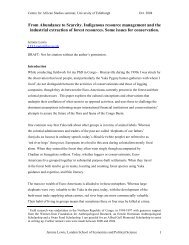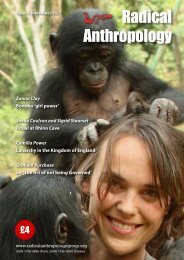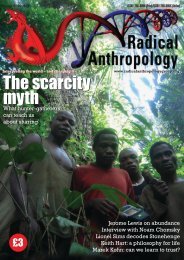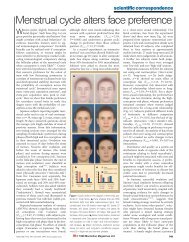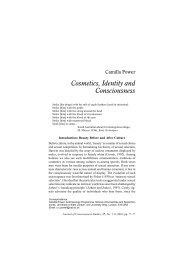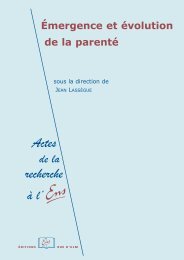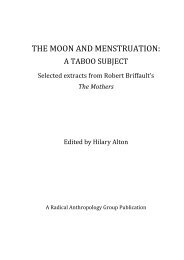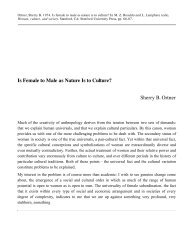Language and life history: A new perspective on the development ...
Language and life history: A new perspective on the development ...
Language and life history: A new perspective on the development ...
- No tags were found...
Create successful ePaper yourself
Turn your PDF publications into a flip-book with our unique Google optimized e-Paper software.
Locke & Bogin: <str<strong>on</strong>g>Language</str<strong>on</strong>g> <str<strong>on</strong>g>and</str<strong>on</strong>g> <str<strong>on</strong>g>life</str<strong>on</strong>g> <str<strong>on</strong>g>history</str<strong>on</strong>g>In <strong>the</strong> first, men who speak in a way that secures attenti<strong>on</strong>are also likely to be high in dominance, as we saw insecti<strong>on</strong> 4.2. The sec<strong>on</strong>d relati<strong>on</strong>ship is between <strong>the</strong>attractive or forceful use of speech <str<strong>on</strong>g>and</str<strong>on</strong>g> testoster<strong>on</strong>e.Testoster<strong>on</strong>e is correlated with, <str<strong>on</strong>g>and</str<strong>on</strong>g> may increase, <strong>the</strong>boldness with which individuals enter a room, <str<strong>on</strong>g>and</str<strong>on</strong>g> <strong>the</strong>tendency to work in public arenas, such as <strong>the</strong> <strong>the</strong>atricalstage or courtroom. Actors generally display high levelsof testoster<strong>on</strong>e (Dabbs et al. 1990; 2001), <str<strong>on</strong>g>and</str<strong>on</strong>g> triallawyers have 30% more testoster<strong>on</strong>e than o<strong>the</strong>r types oflawyers (Dabbs et al. 1998).The more specific link to speech is that trial lawyers, asPhilbrick (1949) wrote, “exercise <strong>the</strong>ir power in court bymanipulating <strong>the</strong> thoughts <str<strong>on</strong>g>and</str<strong>on</strong>g> opini<strong>on</strong>s of o<strong>the</strong>rs” (p. v).They are, according to Dabbs <str<strong>on</strong>g>and</str<strong>on</strong>g> his colleagues, “goodat presenting c<strong>on</strong>crete details in a straight-talking <str<strong>on</strong>g>and</str<strong>on</strong>g>compelling way that dramatically captures <strong>the</strong> attenti<strong>on</strong>of a jury in trial court” (Dabbs et al. 1998, p. 91). Thereare obvious similarities between trial lawyers <str<strong>on</strong>g>and</str<strong>on</strong>g> <strong>the</strong>“Big men” of traditi<strong>on</strong>al societies. In 1984, <strong>the</strong>re were3,827 members of <strong>the</strong> American Associati<strong>on</strong> of TrialLawyers. Men comprised 99.9% of <strong>the</strong> membership(Walter 1988), which is nearly 20% more males thanworked as primary care physicians in <strong>the</strong> following year(Franks & Bertakis 2003). 14 This research suggests thatwomen who are attracted to men with a comm<str<strong>on</strong>g>and</str<strong>on</strong>g>ingway of speaking may get a mate for <strong>the</strong>mselves,<str<strong>on</strong>g>and</str<strong>on</strong>g> fa<strong>the</strong>r for <strong>the</strong>ir children, who has high levels oftestoster<strong>on</strong>e <str<strong>on</strong>g>and</str<strong>on</strong>g> status, <str<strong>on</strong>g>and</str<strong>on</strong>g> unusual access to valuedresources.There are o<strong>the</strong>r, more specific c<strong>on</strong>necti<strong>on</strong>s betweenaspects of <strong>the</strong> male voice <str<strong>on</strong>g>and</str<strong>on</strong>g> several indices of fitness.These include links between depth of vocal frequency<str<strong>on</strong>g>and</str<strong>on</strong>g> both testoster<strong>on</strong>e (Dabbs & Mallinger 1999; Pedersenet al. 1986) <str<strong>on</strong>g>and</str<strong>on</strong>g> testis volume (Harries et al. 1997), wheretestoster<strong>on</strong>e levels independently predict coital frequency(Halpern et al. 1993; 1998; Udry 1988), social expressivity(Dabbs & Ruback 1988), <str<strong>on</strong>g>and</str<strong>on</strong>g> social dominance (Schaalet al. 1996). Reduced formant dispersi<strong>on</strong> is also correlatedwith skull <str<strong>on</strong>g>and</str<strong>on</strong>g> body size in primates, <strong>the</strong> magnitudebeing greater in macaques (Fitch 1997) than in humans(G<strong>on</strong>zález 2004). It is thus unsurprising that our adaptiveancestors availed <strong>the</strong>mselves of this particular medium,which could broadcast fitness informati<strong>on</strong> while simultaneouslytransmitting <strong>the</strong> units of language, to saynothing of <strong>the</strong> social, indexical, <str<strong>on</strong>g>and</str<strong>on</strong>g> emoti<strong>on</strong>al informati<strong>on</strong>that would have been embedded <strong>the</strong>rein (Cheney &Seyfarth 2005b). Recently, it was reported that in bothmen <str<strong>on</strong>g>and</str<strong>on</strong>g> women, opposite-sex ratings of vocal attractivenesspredicted age of first sexual intercourse, numberof sexual partners, number of competing sexual relati<strong>on</strong>ships,<str<strong>on</strong>g>and</str<strong>on</strong>g> number of partners that were involved ino<strong>the</strong>r sexual relati<strong>on</strong>ships (Hughes et al. 2004). Theauthors c<strong>on</strong>cluded that “voice may have been an importantparameter of mate choice” in human evoluti<strong>on</strong> (Hugheset al. 2004, p. 303).In <strong>the</strong> previous secti<strong>on</strong>s, we identified several differentforms of selecti<strong>on</strong> that may have applied across <strong>the</strong> wholeof <strong>development</strong>, from infancy to sexual maturity, including<strong>the</strong> uniquely human stages of childhood <str<strong>on</strong>g>and</str<strong>on</strong>g> adolescence.Our goal in doing so was to offer an evoluti<strong>on</strong>ary accountof our species’ capacity to improvise, learn, <str<strong>on</strong>g>and</str<strong>on</strong>g> c<strong>on</strong>trolcomplex vocalizati<strong>on</strong>s. It is appropriate now that weexamine <strong>the</strong> evoluti<strong>on</strong> of <strong>the</strong> <str<strong>on</strong>g>new</str<strong>on</strong>g> stages <strong>the</strong>mselves.9. Evoluti<strong>on</strong> of <strong>the</strong> <str<strong>on</strong>g>new</str<strong>on</strong>g> stagesWe have proposed that when childhood exp<str<strong>on</strong>g>and</str<strong>on</strong>g>ed, <str<strong>on</strong>g>new</str<strong>on</strong>g>opportunities arose, especially within families, for <strong>the</strong>negotiati<strong>on</strong> of more structured <str<strong>on</strong>g>and</str<strong>on</strong>g> complex forms of vocalizati<strong>on</strong>;<str<strong>on</strong>g>and</str<strong>on</strong>g> that with a premium in this c<strong>on</strong>text <strong>on</strong> h<strong>on</strong>estsignaling, benefits would have accrued to families thatwere able to deploy <strong>the</strong>se more complex forms meaningfully,<str<strong>on</strong>g>and</str<strong>on</strong>g> thus to warn, advise, <str<strong>on</strong>g>and</str<strong>on</strong>g> inform each o<strong>the</strong>r.We have fur<strong>the</strong>r proposed that this material, arisingfrom infancy <str<strong>on</strong>g>and</str<strong>on</strong>g> exp<str<strong>on</strong>g>and</str<strong>on</strong>g>ing in childhood, persisted intojuvenility when it c<strong>on</strong>tributed to teasing, joking, <str<strong>on</strong>g>and</str<strong>on</strong>g>gossip in both sexes, behaviors that would have facilitatedachievement of group-oriented goals; as well as into adolescence,when performative skills c<strong>on</strong>tributed to intrasexualcompetiti<strong>on</strong> <str<strong>on</strong>g>and</str<strong>on</strong>g> epigamic selecti<strong>on</strong>, reinforcingall previous <strong>development</strong>s <strong>on</strong> which those skills depend.We have proposed relati<strong>on</strong>ships between language, atrait unique to humans, <str<strong>on</strong>g>and</str<strong>on</strong>g> two <strong>on</strong>togenetic stages thatare also unique to humans. To underst<str<strong>on</strong>g>and</str<strong>on</strong>g> <strong>the</strong> evoluti<strong>on</strong>of language, <strong>the</strong>refore, we believe it may be necessaryto ask how <str<strong>on</strong>g>and</str<strong>on</strong>g> when <strong>the</strong>se stages came to exist, <str<strong>on</strong>g>and</str<strong>on</strong>g> thiswe attempt to do here. In succeeding secti<strong>on</strong>s, we look atevidence for <strong>development</strong>al c<strong>on</strong>tinuity between <strong>the</strong> levelsof language, <str<strong>on</strong>g>and</str<strong>on</strong>g> interc<strong>on</strong>necti<strong>on</strong>s between language <str<strong>on</strong>g>and</str<strong>on</strong>g><strong>the</strong> rules <str<strong>on</strong>g>and</str<strong>on</strong>g> skills that influence its use, offering speculati<strong>on</strong><strong>on</strong> how <strong>the</strong>se c<strong>on</strong>juncti<strong>on</strong>s may have come about.It is obviously difficult to rec<strong>on</strong>struct <strong>the</strong> evoluti<strong>on</strong> of<str<strong>on</strong>g>life</str<strong>on</strong>g> <str<strong>on</strong>g>history</str<strong>on</strong>g> stages from fossil remains al<strong>on</strong>e. Fortunately,it is possible to draw relevant inferences from syn<strong>the</strong>sesof comparative anatomical, physiological, <str<strong>on</strong>g>and</str<strong>on</strong>g> ethologicaldata, <str<strong>on</strong>g>and</str<strong>on</strong>g> from archaeological findings. This work is facilitatedby parametric data <strong>on</strong> <strong>the</strong> brain <str<strong>on</strong>g>and</str<strong>on</strong>g> body growth ofn<strong>on</strong>human primates, as well as of humans <str<strong>on</strong>g>and</str<strong>on</strong>g> <strong>the</strong>ir ancestors(cf. Harvey & Clutt<strong>on</strong>-Brock 1985; Harvey et al. 1987;Martin 1983).9.1. Evoluti<strong>on</strong> of childhoodWith an <strong>on</strong>togenetic approach to linguistic evoluti<strong>on</strong>,structures o<strong>the</strong>r than <strong>the</strong> skull become important. Forexample, teeth <str<strong>on</strong>g>and</str<strong>on</strong>g> jaws are useful because of <strong>the</strong> str<strong>on</strong>gcorrelati<strong>on</strong> between tooth formati<strong>on</strong> <str<strong>on</strong>g>and</str<strong>on</strong>g> erupti<strong>on</strong> <str<strong>on</strong>g>and</str<strong>on</strong>g>o<strong>the</strong>r <str<strong>on</strong>g>life</str<strong>on</strong>g> <str<strong>on</strong>g>history</str<strong>on</strong>g> events (Smith & Tompkins 1995).Figure 3 is an attempt to represent <strong>the</strong> evoluti<strong>on</strong> ofhuman <strong>development</strong>, though at present <strong>the</strong> <strong>on</strong>ly reliabledata are associated with Pan <str<strong>on</strong>g>and</str<strong>on</strong>g> H. sapiens. Known orestimated adult brain sizes are given at <strong>the</strong> top of eachbar. Mean age at erupti<strong>on</strong> of <strong>the</strong> first permanent molar(M1) is graphed across <strong>the</strong> histograms, <str<strong>on</strong>g>and</str<strong>on</strong>g> identifiednumerically at <strong>the</strong> base (Smith & Tompkins 1995).Appearing about 3.9 milli<strong>on</strong> years ago, Australopi<strong>the</strong>cusafarensis shares many anatomical features with n<strong>on</strong>homininp<strong>on</strong>gid (ape) species, including an adult brainsize of about 400 cc <str<strong>on</strong>g>and</str<strong>on</strong>g> a pattern of dental <strong>development</strong>indistinguishable from extant chimpanzees (C<strong>on</strong>roy &Vannier 1991; Dean et al. 2001; Sim<strong>on</strong>s 1989; Smith1991). Therefore, <strong>the</strong> chimpanzee <str<strong>on</strong>g>and</str<strong>on</strong>g> A. afarensis aredepicted as sharing <strong>the</strong> typical tripartite stages of postnatalgrowth of social mammals: infancy, juvenility, <str<strong>on</strong>g>and</str<strong>on</strong>g> adulthood(Pereira & Fairbanks 1993). Following <strong>the</strong> definiti<strong>on</strong>soffered earlier, infancy represents <strong>the</strong> period offeeding by lactati<strong>on</strong>, juvenility represents a period offeeding independence prior to sexual maturati<strong>on</strong>, <str<strong>on</strong>g>and</str<strong>on</strong>g>272 BEHAVIORAL AND BRAIN SCIENCES (2006) 29:3



